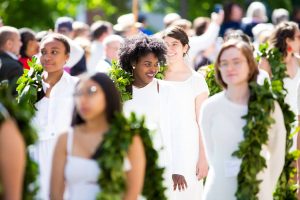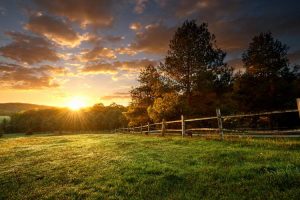Our website highlights several recent perspectives on the season and how the holidays in different religious traditions incorporate spring. I have always found it to be so profound how the religious traditions; celebrating their own stories and events; are so often in line with the rhythms of the natural world.
One of the functions of religious festivals is to help us mark transitions in our communal, social, and spiritual lives. We also call on ritual in a non-sectarian way, creating celebrations and rites of passage to mark beginnings and endings.

Ivy Day 2017
As we wind down the academic year at smith, the shifts taking place, particularly the seniors receiving their degrees, are celebrated via several different events which have been practiced in the institution over generations (Baccalaureate, Ivy Day, Commencement).
Thinking about rituals and how they help us mark communal and social milestones, I am reminded of all those whose transitions are abrupt or forced and not accompanied by any rite or celebration. In particular, I am thinking of refugees and even immigrants and migrants who make colossal transitions to a new life and must “jump into the middle,” sometimes just in order to survive.
Marking transitions is an important human need, and our current North American social milieu is not rich with ritual observance. Joseph Campbell, a famous “mythologist,” talks about the human need for ritual:
[B]y participating in (a) ritual, you are participating in (a) myth. And since myth is a projection of the depth wisdom of the psyche, by participating in a ritual, participating in the myth, you are being, as it were, put in accord with that wisdom, which is the wisdom that is inherent within you anyhow. Your consciousness is being re-minded of the wisdom of your own life.
 Sometimes we must create our own rituals in order to help ourselves and those around us mark transitions. This could be reflective writing, lighting candles, or sometimes a special meal. As we move toward the summer solstice on June 20, let us take stock of the transitions happening in the earth, in ourselves and our communities around us. At the same time, in the words of Buddhist teacher Thich Nhat Hanh, one way to mark transitions is to practice mindfulness and simply notice what is happening in our midst:
Sometimes we must create our own rituals in order to help ourselves and those around us mark transitions. This could be reflective writing, lighting candles, or sometimes a special meal. As we move toward the summer solstice on June 20, let us take stock of the transitions happening in the earth, in ourselves and our communities around us. At the same time, in the words of Buddhist teacher Thich Nhat Hanh, one way to mark transitions is to practice mindfulness and simply notice what is happening in our midst:
To dwell in the here and now does not mean you never think about the past or responsibly plan for the future. The idea is simply not to allow yourself to get lost in regrets about the past or worries about the future. If you are firmly grounded in the present moment, the past can be an object of inquiry, the object of your mindfulness and concentration. You can attain many insights by looking into the past. But you are still grounded in the present moment.
Sometimes the meaning of the transitions around us can unfold and bear more fruit in our lives when we commit to a practice of noticing and acknowledging—this is a first step. The Smith CRSL has undergone many transitions over the past 12 months, and we are excited about the ways we will be noticing, marking, and even celebrating these transitions. So stay tuned and look for our next newsletter, where we will be talking more about what is to come and inviting you to help us change and grow.
